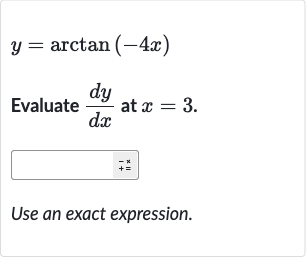AI tutor
Full solution
Q. Evaluate at .Use an exact expression.
- Differentiate using chain rule: step_1: Differentiate with respect to using the chain rule.The derivative of with respect to is , so by the chain rule, .
- Calculate derivative of : step_2: Calculate the derivative of with respect to .
- Substitute derivative into result: step_3: Substitute the derivative of into the result from step .\frac{dy}{dx} = \left(\frac{1}{1+(\-4x)^2}\right) * (\-4).
- Simplify expression for : step_4: Simplify the expression for ..
- Evaluate at : step_5: Evaluate at . at is .
- Calculate exact expression at : step_6: Calculate the exact expression for at . at is .
- Simplify the denominator: step_7: Simplify the denominator..
- Add numbers in the denominator: step_8: Add the numbers in the denominator. .
- Write final expression for : step_9: Write the final expression for at . at is .

